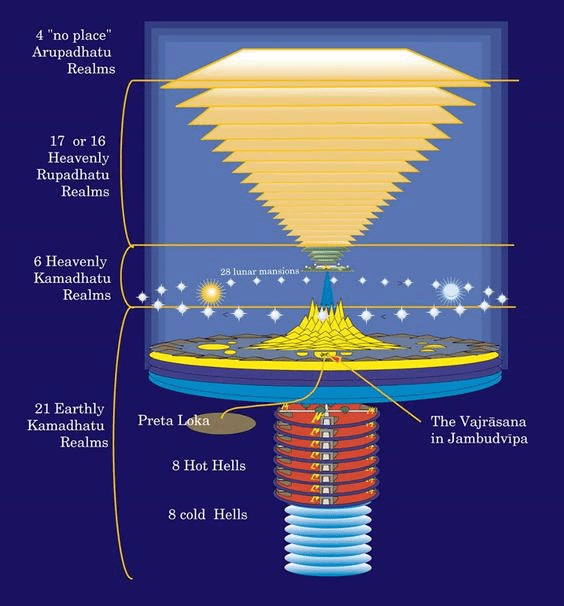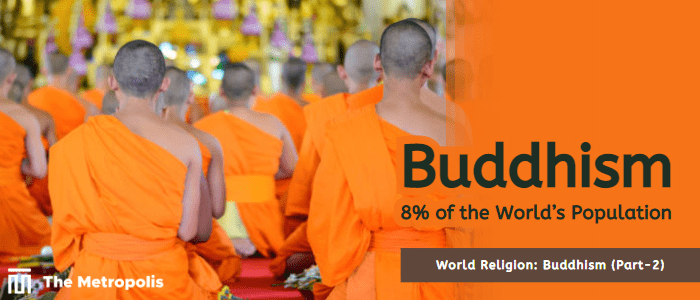Anjum Anam –
Buddhism is a religion and philosophy that developed from the teachings of the Buddha, a teacher who lived in northern India between the mid-6th and mid-4th centuries BCE (before the Common Era). Spreading from India to Central and Southeast Asia, China, Korea, and Japan, Buddhism has played a central role in the spiritual, cultural, and social life of Asia. From the beginning of the 20th century, it spread to the West as well.
Buddhist Cosmology

According to Buddhist cosmology, there are 6 heavenly Kamdhatu regions above the earth. The moon, sun, and stars revolve around the mountain that separates them from the Earth.
The 17 materialistic heavenly layers above them are known as the Rupdhatu Realms, and the 4 non-materialistic heavenly layers above them are known as the Arupdhatu Realms (the location of Nirvana). There is no room for karma or form and all is invisible, fortunate, and spiritual.
The 21 earthly kamdhatu realms start at Bhuloka, or Earth, and move downward. Bhuloka contains 5 realms, to start. 8 Realms of Hot Hell are listed below that, followed by 8 Realms of Cold Hell. There is another area with ghosts and unfulfilled souls living in it, known as Preta Loka.
Beliefs
Buddhism holds that craving and clinging to impermanent people, places, and things is painful and causes suffering. It is known as Dukkha, which means “incapable of satisfying”. This keeps us trapped in Saṃsāra, the eternal cycle of repeated rebirth, dukkha, and death. Following the Noble Eightfold Path is the way to break free from this never-ending cycle and achieve nirvana.
-
The wheel of life is called Bhavachakra:
The pig, rooster, and snake in the wheel’s hub stand in for the 3 deadly sins of ignorance, attachment, and aversion. It results in karma.
The 2nd layer stands for karma. One half-circle (often light) depicts contented individuals rising to higher states, perhaps to the heavenly realms. The opposite half of the circle, which is typically dark, depicts sorrowful individuals being escorted to lower places.
The 3rd layer represents the 6 realms of Saṃsāra. God realm, Demi-God realm, and Human realm are the 3 higher realms that are represented in the top half of the circle. The bottom half of the circle displays the 3 lesser realms: The Animal realm, the Hungry Ghost realm, and the Hell realm.
The 4th layer is divided into 12 sections that represent the 12 Nidānas. As previously stated, the 3 inner layers of the wheel show that the 3 poisons lead to karma, which leads to the suffering of the 6 realms. The 12 links of the outer rim show how this happens—by presenting the process of cause and effect in detail.
The 12 links can be observed to span numerous lifetimes on the outer level. They illustrate how our past lives influence our present life and how our choices in this life affect our future lifetimes.
It is conceivable to understand the 12 connections’ interactions with one another at every moment of existence on an inner level. The effects of an action on this level can be shown using the 12 links.
By thinking about the 12 links, one can obtain a better understanding of how karma operates. With this understanding, we can start to break our habituated patterns of thinking and behavior.
The 12-causal links, paired with their corresponding symbols, are:
-
Avidyā (lack of knowledge) – a blind person, often walking, or a person peering out
-
Saṃskāra (constructive volitional activity) – a potter shaping a vessel or vessels
-
Vijñāna (consciousness) – a man or a monkey grasping a fruit
-
Nāmarūpa (constituent elements of mental and physical existence) – two men afloat in a boat
-
Ṣaḍāyatana (six senses – eye, ear, nose, tongue, body, and mind) – a dwelling with six windows
-
Sparśa (contact) – lovers consorting, kissing, or entwined
-
Vedanā (feeling) – an arrow to the eye
-
Tṛṣṇa (thirst) – a drinker receiving a drink
-
Upādāna (grasping) – a man or a monkey picking fruit
-
Bhava (coming to be) – a couple engaged in intercourse, a standing, leaping, or reflective person
-
Jāti (being born) – woman giving birth
-
Jarāmaraṇa (old age and death) – corpse being carried
The wheel is being held by a fearsome figure who represents impermanence. This figure is frequently understood as Yama, the lord of death, or as Mara, the demon who tried to entice the Buddha. The core message, which is that everything within this wheel is always changing, is the same regardless of the figure used to represent the cycle of existence (samsara).
The moon above the wheel represents liberation from samsara or cyclic existence. This means the end of rebirth.
The Buddha pointing to the white circle indicates that liberation is possible.
-
Four Noble Truths are the Cause of Rebirths
-
Dukkha (Unsatisfactoriness/Suffering) is one of the three marks of existence that are inherent to life in the world of samsara. 3 primary “types of suffering” are described in Buddhist teachings. The first is called “the suffering of suffering”, the second is “the suffering of change”, and the third is “the suffering of conditioning”. The first category includes the unpleasant events that are a natural part of being a person, such as birth, illness, old age, and death. The second kind is joyful or enjoyable. In a dualistic view, they represent the relief or antithesis of suffering. And because change is an inevitable element of life, joy eventually transforms into something else, giving rise to the sense of dukkha. The third sort of suffering is the existential knowledge that as long as we continue to live in an unenlightened existence, suffering will always remain. There will always be a source of misery. This insight might trigger an existential crisis.
-
Samudaya (Cause): taṇhā (thirst) is the cause or a continuation of dukkha. While taṇhā is traditionally interpreted in Western languages as the ’cause’ of dukkha, it can also be considered as the force connecting us to dukkha or as a reaction to dukkha, seeking to escape it; The five aggregates or heaps of clinging are:
-
Form or impression (Rupa)
-
Sensations or feelings (Vedana)
-
Perceptions (Samjna)
-
Mental activity or formations (Sankhara)
-
Consciousness (Vijnana)
-
Nirodha (confinement): The giving up or renunciation of taṇhā can put an end to or confine dukkha. The confinement of taṇhā releases the excessive bind of dukkha.
-
Marga (Noble Eightfold Path): The path leading to the confinement of tanha and dukkha
-
Liberation/ Nirvana
The Noble Eightfold Path is one of the lists in the Bodhipakkhiyā dhamma. It is a term used in the Pali commentaries to describe seven groups of characteristics or means to awaken that are frequently attributed to the Buddha throughout the Pali Canon, each of which summarizes the Buddhist path. There are a total of 37 overlapping and repeated components or qualities within these seven sets of awakening attributes.
Four Establishments of Mindfulness
-
Mindfulness of the body
-
Mindfulness of feelings
-
Mindfulness of mental states
-
Mindfulness of mental qualities
Four Establishments of Mindfulness
-
Exertion for the prevention of unskillful states to arise
-
Exertion for the abandoning of the already arisen unskillful states
-
Exertion for the arising of skillful states
-
Exertion for the sustaining and increasing of arisen skillful states
Four Bases of Magical/ Mental/ Supernatural Power
-
Will
-
Energy
-
Consciousness
-
Examination
Five Spiritual Faculties
-
Conviction
-
Energy
-
Mindfulness
-
Unification
-
Wisdom
Five Strengths
-
Conviction
-
Energy
-
Mindfulness
-
Unification
-
Wisdom
Seven Factors of Awakening
-
Mindfulness
-
Investigation
-
Energy
-
Joy
-
Tranquility
-
Unification
-
Equanimity
Noble Eightfold Path
Stages of Rebirth & Liberation
4. 3 Treasures That Help People to Get Nirvana
-
The Buddha, the fully enlightened one.
-
The Dharma, the Buddhist teachings expounded by the Buddha
-
The Sangha, the monastic order of Buddhism that practices and preserves the Dharma.
Which leads to 5 percepts of life. These are seen as basic training applicable to all Buddhists. They are:
-
“I undertake the training precept (Sikkha-Padam) to abstain from the onslaught on breathing beings.”
-
“I undertake the training precept to abstain from taking what is not given.”
-
“I undertake the training precept to abstain from misconduct concerning sense-pleasures.”
-
“I undertake the training precept to abstain from false speech.”
-
“I undertake the training precept to abstain from alcoholic drinks or drugs that are an opportunity for heedlessness.”
5. Meditation
The action which leads to heavenly rebirth, The four immeasurable or four abodes, also called Brahma-viharas, are virtues or directions for meditation in Buddhist traditions, which helps a person be reborn in the heavenly (Brahma) realm. These are traditionally believed to be characteristic of the deity Brahma and the heavenly abode he resides in.
The four Brahma-vihara are:
-
Loving kindness, is active goodwill toward all
-
Compassion, is identifying the suffering of others as one’s own;
-
Empathetic joy, is the feeling of joy because others are happy, even if one did not contribute to it; it is a form of sympathetic joy;
-
Equanimity, is even-mindedness and serenity, treating everyone impartially.



